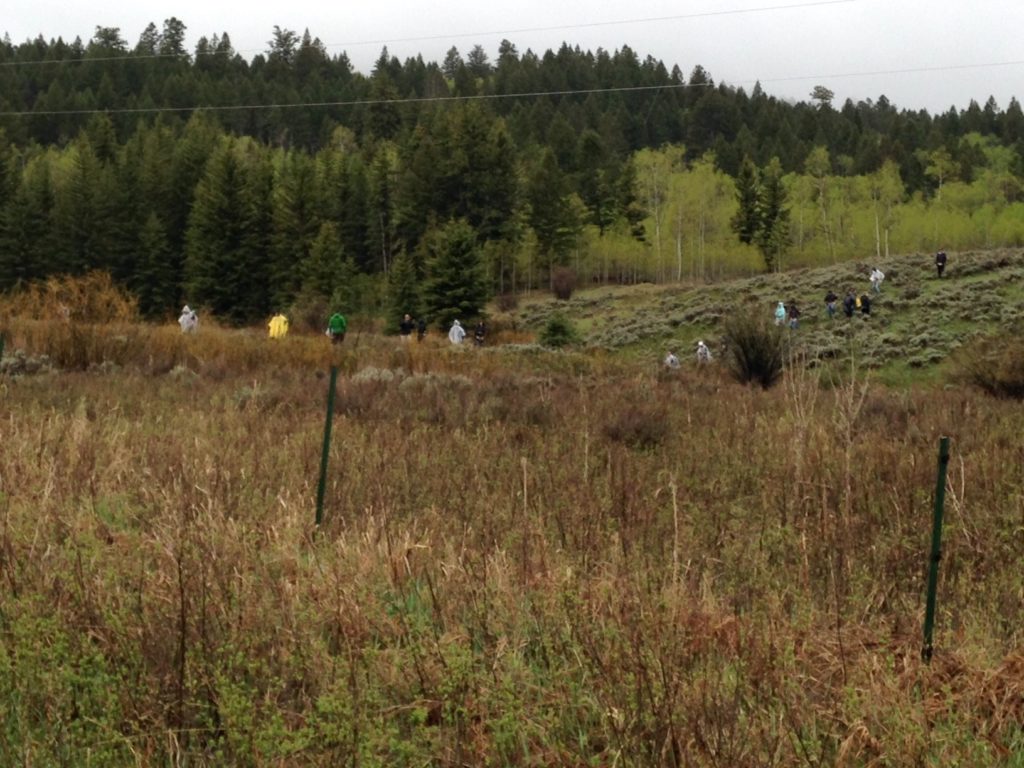by Jon Mobeck, Executive Director
A steady rain saturated the ground as I looked out the window. It was 5:30 a.m. on the day of a fence pull – Saturday, May 12. It’s hard not to feel that a bit more sleep would be a better choice than pulling down barbed wire fences, but that fleeting thought is dismissed as I think about the others who are doing – and maybe thinking – the same thing. I’ve done this work in the rain before, but nowhere near as many times as those key “Fence Team” volunteers who I would join later that morning. And then I have the thought of all the people who have done this over the past two decades, in all sorts of weather conditions, in any terrain. There was never really a doubt that we would pull down fence that day.
On this day, we were scheduled to benefit from a large volunteer crew generously offered by EcoTour Adventures. EcoTour was hosting a group of 16 students from a school in Louisiana along with an equal number of parents. While visiting (vacationing) here, the Louisianans would see the typically amazing sites of Jackson Hole, experience exhilarating adventures, and learn about the area’s wildlife and natural gifts from EcoTour’s exceptional guides. Because of EcoTour’s commitment to the area’s wildlife, they encourage their guests to participate in activities that help preserve what makes this place special.

On this day, though, with rain coming down and more rain forecast throughout the day, I had assumed that the group would cancel, and I wouldn’t have blamed them for a second. After all, they were on vacation. Pulling down barbed wire fences in the rain is not high on the “to-do” list for most of the vacationing public.
So at 7:22 a.m., when EcoTours CEO Taylor Phillips texted: “OK we are all in for the fence pull. Expected arrival 9:15. Yahoo!” I was surprised. I knew I would be meeting our indefatigable Fence Team volunteer leaders Gretchen, Steve and Randy since we had all decided that we were going no matter the weather, but now the prospect of our small team working through the rain turned into the excitement of a huge group (41) of us doing so together.

As it turned out, the rain was relatively light throughout most of the project, and I was amazed by the resilience of the Louisianans. I suppose they are accustomed to rain, but as one of the parents – James – said, “We don’t get to do anything like this in Louisiana.” The Louisianans worked for 3 hours with us, and it sure seemed like they were having a good time. That knowledge filled me with joy. Here all of us were, in the rain, removing barbed wire fences to make things easier for wildlife. And it was fun! And it reminded me of how great it is to share such an experience with new people, from a different place. We’re all so similar, and we all can do so much together!
Of course, we do this for the wildlife. On this occasion, we worked in an area at the northernmost end of the recently mapped Red Desert-to-Hoback Mule Deer Migration Route. The Wyoming Migration Initiative elucidated this 150-mile route through extensive GPS collaring and subsequent mapping that is now recognized and discussed around the world. Each spring, mule deer that were once thought to be a resident population of the Red Desert region migrate across and through many roads, houses, industrial developments, and about 100 fences before finding summer range in the greater Hoback area. We worked near those summer ranges, where they will spend considerable time, removing obstacles that can separate fawns from does, and just generally make their route more challenging.

The northern end of the Red Desert to Hoback Mule Deer Migration Route, as identified by Wyoming Migration Initiative, which includes summer range for mule deer.
We were on Bridger-Teton National Forest Land, where we removed about ½ mile of nasty barbed wire fences. It is a privilege to be able to support our agency partners who couldn’t possible deploy enough staff members to remove or maintain every fence in the region. Our volunteer fence pullers pitch in to care for our public lands in partnership with those terrific land managers.
Hundreds of individuals have helped in this way over the past two decades. Some of whom have been on hundreds of fence projects. I’m personally grateful to all of them, and when I pull my boots on to go work on fences, I know that I’m part of something much bigger than me, in so many ways. It is a big, impressive landscape. It is an amazingly long mule deer migration. There are so many people over many years. There is still so much to do.
Thank you to those great young people from Louisiana and their parents, and to EcoTour Adventures. We’re all a part of a great tradition of giving back to the land!
